Who doesn’t love hummingbirds? Having the tiny birds grace your yard is always a treat. You can find a variety of hummingbird feeders at most nurseries and outdoor stores, all designed to entice the birds to visit you. Most of the feeders require upkeep, with fresh sugar water added regularly. Additionally, if you live in bear country, you need to remember to bring the feeders indoors at night. Otherwise, you may attract unwanted visitors.
While all that effort is worth it, so you can catch a glimpse of the beautiful birds, there is an even better way to attract your flitting friends. Adding hummingbird-friendly plants to your yard will bring them in droves and ensure they get high-quality nectar. And even better, the plants will attract other pollinators, which will help improve the biodiversity of your garden or yard. Plus, they come with the added bonus of blossoms of richly colored flowers in the spring or summer.
But deciding what to add can take a lot of time and research. So we wanted to help get you started. Below you can explore seven plants that attract hummingbirds and decide if one (or more) is suitable for your space.
1. Petunia (Petunia)
This familiar flower has an intoxicating fragrance. If you add it to your garden or yard, both you and the hummingbirds will win.
Why They Attract Hummingbirds:
Petunias are rich in nectar and come in vibrant colors to attract the tiny birds.
Description:
The plants are relatively wide due to their multi-branching nature. The leaves are sticky and hairy. Petunia blossoms come in nearly any color and typically bloom from spring under the first frost. Its lovely flowers are wide and trumpet-shaped.
Depending on the species, petunias will either stand erect or sprawl out. They can grow up to 18 inches tall. And they have a spread of up to 4 feet when left to their own devices.
USDA Hardiness Zones:
Perennial to Zones 9-11, but will grow as annuals in all other zones.
Sourcing:
Wherever you buy your seeds, or plant starts.
Growing Conditions:
These stunning flowers grow equally well in a garden bed and containers if you are short on space. With over thirty varieties available, you can find one perfectly suited to your area. They require full sun to thrive but can survive with as little as five hours of sunlight each day.
It is a resilient species and can survive in less-than-ideal soil conditions. The only thing it needs is a well-draining soil. Additionally, petunias are heat tolerant and do not require a lot of water.
Bonus:
According to mythology, petunias have the ability to ward off negativity, monsters, and spirits.
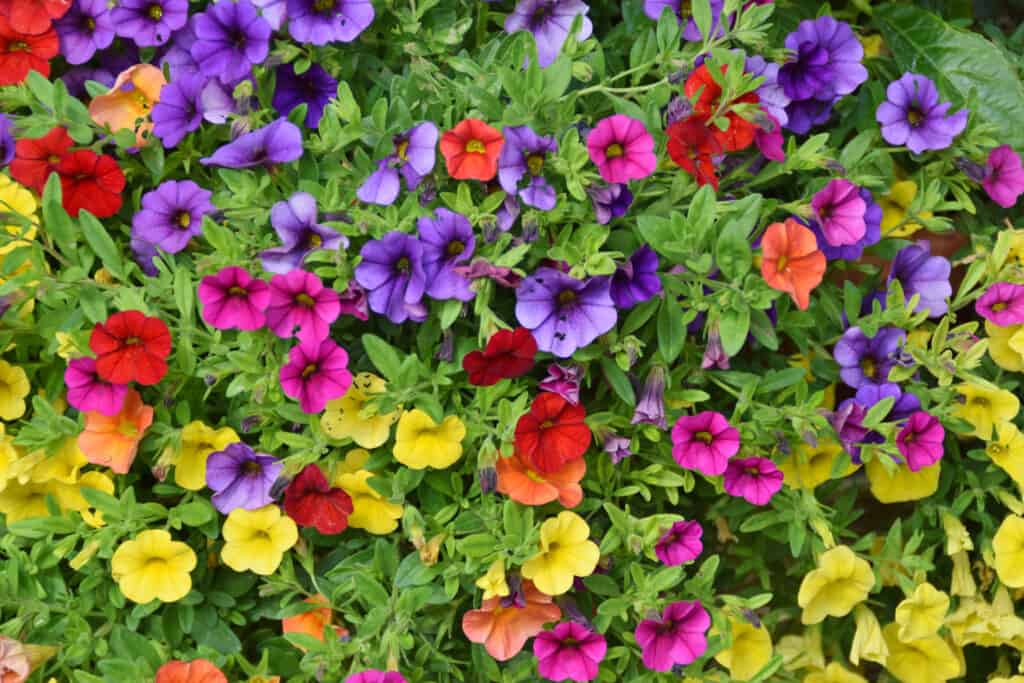
The striking color of petunias will attract many hummingbirds.
©Eleonora Scordo/Shutterstock.com
2. Scarlet Bee Balm (Monarda didyma)
You have likely seen bee balm seeds at your nursery while browsing the new seed packet arrivals each spring. However, scarlet bee balm is a step up thanks to its stunning red flowers.
Why They Attract Hummingbirds:
Hummingbirds love their long, narrow, and tubular flowers. The nectar is located lower down in the flower. So hummingbirds’ long proboscises are perfect for the job of reaching it.
Description:
Monarda didyma is an aromatic perennial and a member of the Lamiaceae (mint) family. Its solitary, bright scarlet flowers bloom from June through September. It can grow between 2-5 feet tall and has hairy, branched stems.
USDA Hardiness Zones:
This beautiful plant is a perennial in Zones 4-9.
Sourcing:
You can purchase seeds from your local nursery or order from a reputable online seed supplier.
Growing Conditions:
Scarlet Bee balm prefers well-draining, moist conditions. A location with full sun is ideal. However, it can adapt to a partially shaded environment over time. You can broadcast seeds in the spring or start trays of seedlings indoors for later transplant.
Bonus:
Not only does Monarda didyma offer you beautiful flowers and attract a ton of pollinators, but it also has many medicinal uses.
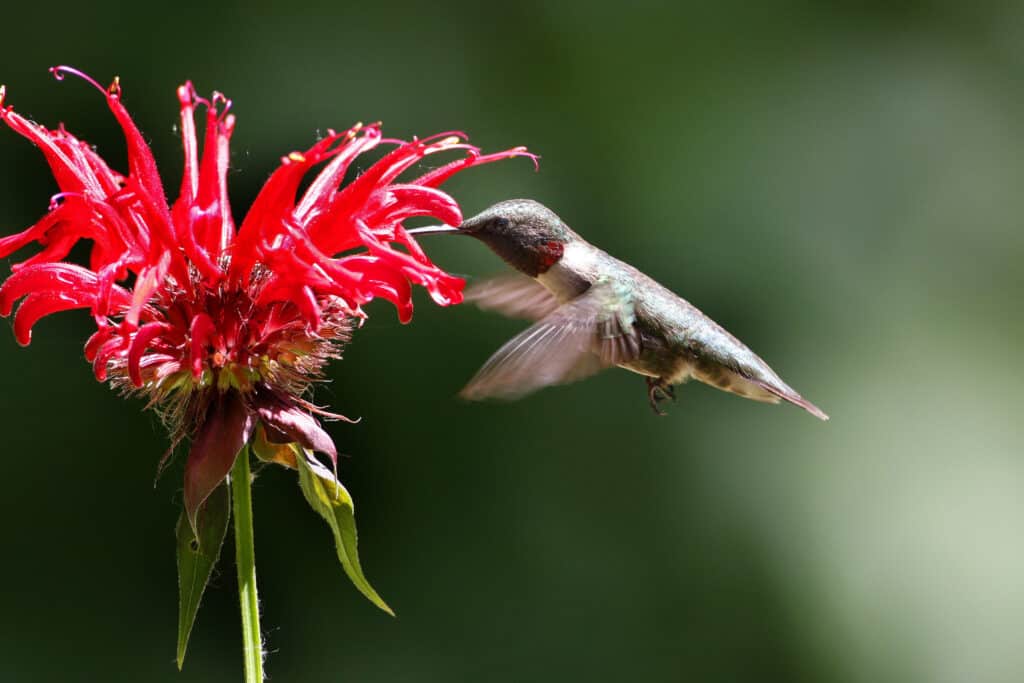
Hummingbirds love bright, vibrant scarlet bee balm flowers.
©Chris Alcock/Shutterstock.com
3. Bluestem Penstemon (Penstemon cyanocaulis Payson)
This gorgeous plant is also known as dusty beardtongue or bluestem beardtongue. It is perfect in xeriscape environments or during restoration efforts after a fire.
Why They Attract Hummingbirds:
With a long, tubular shape, the bluestem penstemon flowers offer the perfect feeding ground for hummingbirds.
Description:
Penstemon cyanocaulis has a woody base, from which one to multiple stems protrude. It grows between 8 inches and 1.5 feet high. The flower clusters at the end are a stunning blue.
USDA Hardiness Zones:
You can successfully grow this plant in Zones 3-8.
Sourcing:
Contact seed companies in Colorado, New Mexico, Utah, or Arizona, as these stunning plants thrive in the southwestern United States.
Growing Conditions:
Bluestem penstemon is drought tolerant and relatively versatile. It makes the ideal addition to drier areas along the edge of landscaped areas, as it can tolerate either partial shade or full sun.
Direct seeding is the best propagation method for bluestem penstemons. However, they will survive as transplanted seedlings if you need to start them indoors.
Bonus:
While the plants attract pollinators, like hummingbirds, they also provide the perfect hiding spot for small birds.
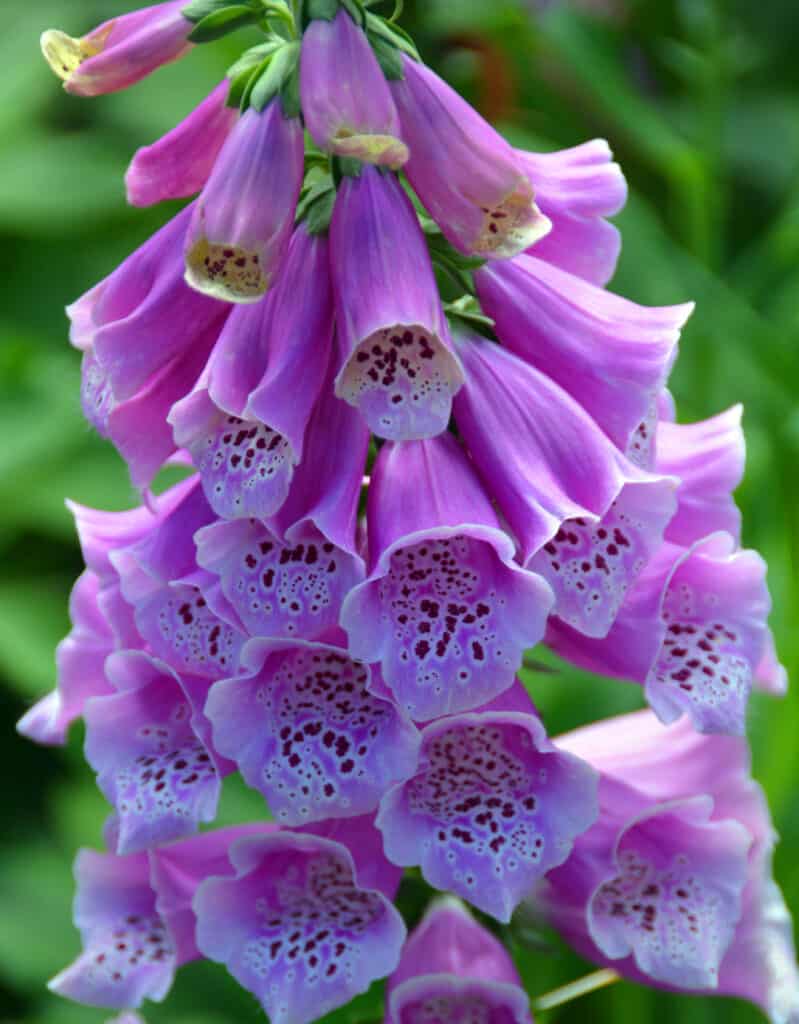
Hummingbirds love the long, tubular shape of bluestem penstemon flowers.
©meunierd/Shutterstock.com
4. Red Columbine (Aquilegia canadensis)
Columbines are delicate flowers that grace even the toughest of landscapes and natural areas. Opt for the red to bring in your favorite winged friends.
Why They Attract Hummingbirds:
The red columbine is one of the most important nectar sources for hummingbirds. When you plant it, you will not only attract beautiful birds to your yard, but you will also provide them with a valuable food source. Hummingbirds thrive on tasty nectar located inside the tubular flowers.
Description:
This perennial grows between 12 and 30 inches tall. It has compound leaves and a downward-facing flower. The red columbine flower showcases a beautiful light red and yellow color combination that blooms between March and July.
USDA Hardiness Zones:
You can grow red columbine in Zones 3-8.
Sourcing:
You can purchase seed packets from your favorite online store or a local nursery.
Growing Conditions:
Once planted, this hardy flower will live between three to five years and is easily re-seeded. The above-ground plant dies back in the fall but regrows in the spring. It thrives in slightly drier conditions. So the red columbine will happily take up space in your yard or garden that other plants do not love. It prefers well-draining and slightly acidic soil.
Indoor seed starts or direct sowing are the best way to propagate red Columbine. Never fear if the gorgeous flowers don’t show up right away. They will not bloom until the plant’s second year.
Bonus:
The roots and seeds have medicinal value.
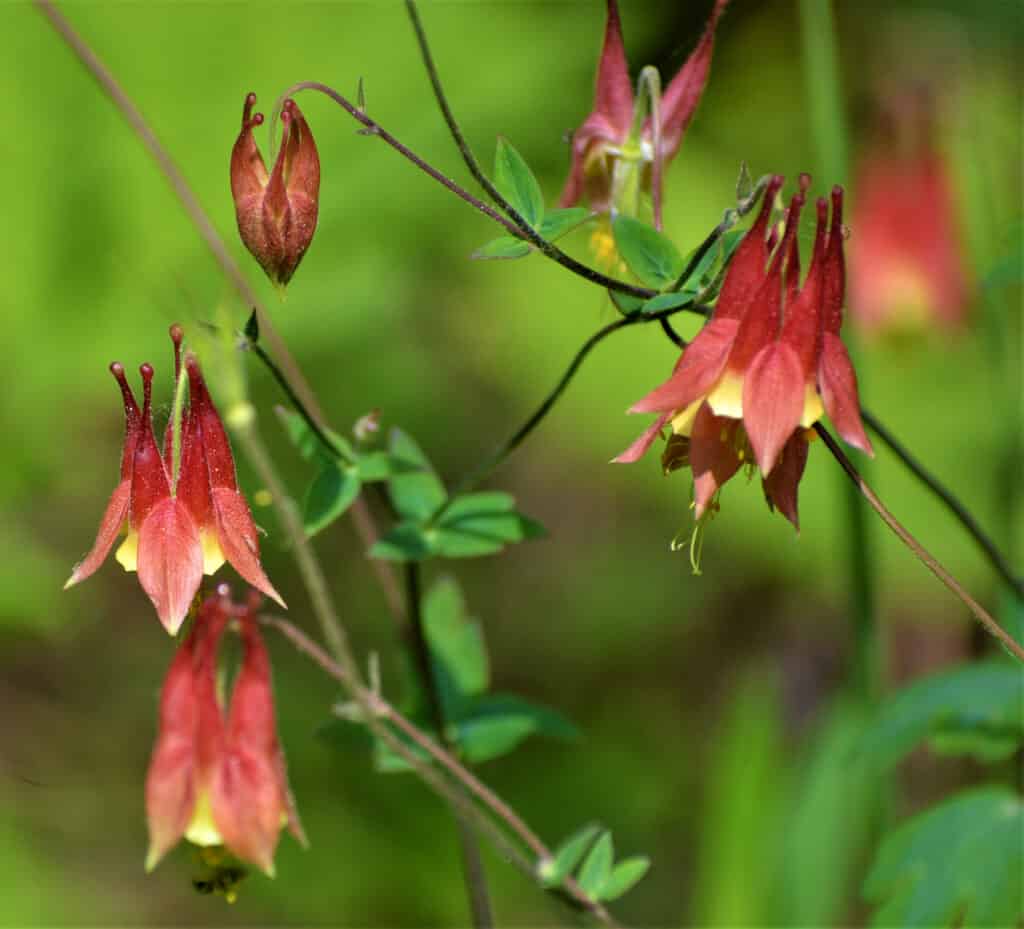
Red columbine flowers are one of the most important food sources for hummingbirds.
©akslocum/Shutterstock.com
5. Bigleaf Lupine (Lupinus polyphyllus)
There are countless varieties of lupine available. They are available in a wide range of colors and sizes. The flowers of the bigleaf lupine come in shades preferred by hummingbirds, making them the ideal choice for your next garden addition.
Why They Attract Hummingbirds:
The flowers of the bigleaf lupine have an abundance of rich nectar that hummingbirds love.
Description:
Lupinus polyphyllus is a beautiful ornamental and offers a delightful fragrance. Technically a legume, this stunning plant has a varied growing pattern. Some will grow as tall as 5 feet. Others will grow wide but only reach 6-12 inches high.
The bigleaf lupine has hollow stalks and large leaves. Its flower bunches can grow between 3 inches to 1.5 feet tall. And the flower colors range from a whitish-pink to a purple-tinted blue, which blooms between May and August.
USDA Hardiness Zones:
It will grow well in Zones 4-8.
Sourcing:
You can order seed packets online from many suppliers. Or check with your local nursery to see if they carry starts.
Growing Conditions:
Bigleaf lupine plants prefer moist soil but will tolerate some seasonally dry conditions. You can add this lupine varietal to nearly any area, and it will adapt, making it highly versatile.
Bonus:
High quantities of the seeds are toxic. So use caution around planting and storing if you have livestock or an abundance of wildlife.

The bright vibrant color of bigleaf lupine flowers attract hummingbirds, and the tasty nectar entices them to stay.
©Nadya So/Shutterstock.com
6. Orange Honeysuckle (Lonicera ciliosa)
The vines of the orange honeysuckle can spread along the ground or can be grown as a climber. They are known to reach up to 20 feet high.
Why They Attract Hummingbirds:
Their trumpet-shaped flowers provide just the right home for the nectar that hummingbirds love.
Description:
The orange honeysuckle is a vining perennial. There are two leaves fused together that have a rounded appearance. Its stunning flowers come in an orange hue and grow in densely packed clusters at the end of a leaf pair.
USDA Hardiness Zones:
These stunning vines can adorn yards in Zones 5-9.
Sourcing:
You can find the seeds at your local nursery, which may also carry starter plants. Or, if you know someone with a thriving plant, you can also successfully propagate your own using cuttings.
Growing Conditions:
This plant is not picky at all. It will grow well in environments ranging from shade to full sun exposure. You can propagate from cuttings, seeds, or starter plants.
Bonus:
Orange Honeysuckles also offer extensive benefits to bee populations.
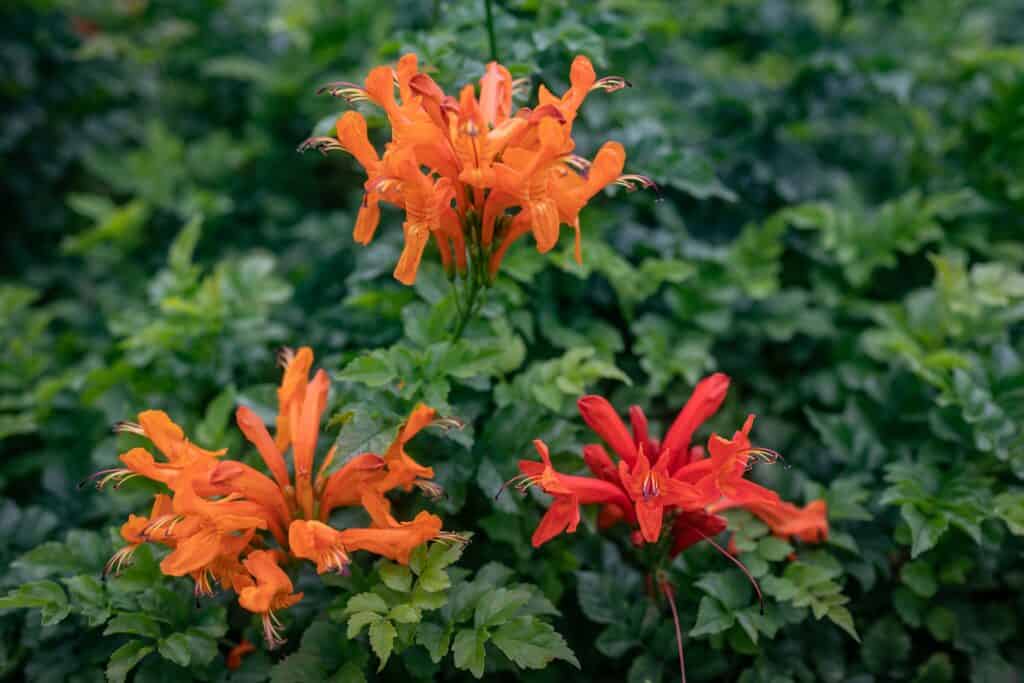
Orange honeysuckle flowers have trumpet-shaped leaves that hummingbirds adore.
©Amovitania/Shutterstock.com
7. Trumpet Creeper (Campsis radicans)
The beautiful trumpet creeper comes with a slight warning. Mammals react upon rubbing up against this stunning vine. If you accidentally come in contact with it, expect skin redness and swelling. It is also slightly toxic, so avoid adding this to your edible flower garden!
If that did not make you shy away, and you are still interested in adding this vine, the hummingbirds will thank you.
Why They Attract Hummingbirds:
Trumpet creepers have stunning, tubular flowers that produce a significant amount of nectar.
Description:
A creeping vine, this plant has long and slender stems, which makes it ideal as a groundcover or to cover trellises and fences. The tubular flowers come in colors ranging from red to yellow-orange. They grow up to 3 inches long and 1.5 inches wide and in clusters between 4 and 12 flowers. Flowers bloom in the height of summer, from July through August.
USDA Hardiness Zones:
Trumpet creepers are perennial in Zones 4-10.
Sourcing:
The trumpet creeper is considered an invasive weed in some regions. Check with your local extension office or nursery to find out if you can add it to your garden.
Growing Conditions:
Plant trumpet creepers in areas that receive full sun for the best blossoms. The plants will survive in a wide variety of conditions. They like wet to dry soil and can grow in sandy, loamy, or clay conditions.
Bonus:
Butterflies also love to visit this climbing flower.
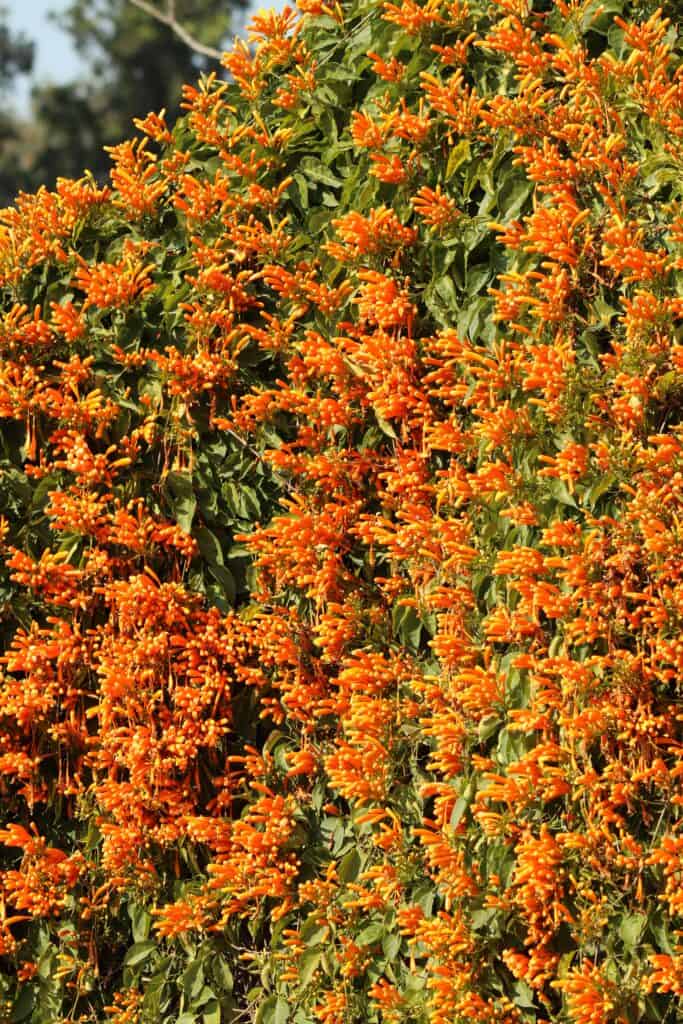
Trumpet creepers have long, tubular flowers that hummingbirds love to visit.
©SUDARSHAN BHATLA/Shutterstock.com
The photo featured at the top of this post is © Birdiegal/Shutterstock.com
Sources
- University of Minnesota, Available here: https://extension.umn.edu/flowers/growing-petunias
- Wildflower.org, Available here: https://www.wildflower.org/plants/result.php?id_plant=loci3
- USDA.gov, Available here: https://plants.usda.gov/DocumentLibrary/plantguide/doc/pg_cara2.docx
- USDA.gov, Available here: https://plants.usda.gov/DocumentLibrary/plantguide/doc/pg_modi.docx
- USDA.gov, Available here: https://plants.usda.gov/DocumentLibrary/plantguide/pdf/pg_aqca.pdf
- USDA.gov, Available here: https://plants.usda.gov/DocumentLibrary/plantguide/pdf/pg_lupo2.pdf
- USDA.gov, Available here: https://plants.usda.gov/DocumentLibrary/plantguide/pdf/pg_lupo2.pdf
- USDA.gov, Available here: https://plants.usda.gov/DocumentLibrary/plantguide/pdf/pg_pecy4.pdf
- Kiddle, Available here: https://kids.kiddle.co/Petunia
FAQs (Frequently Asked Questions)
What color of flowers do hummingbirds like?
They are particularly partial to red hues. However, any brightly colored, tubular flower can attract hummingbirds.
Are there flowers that hummingbirds do not like?
Yes, there are. Some of the flowers hummingbirds are not fond of include daffodils, lilacs, gardenias, and forget-me-nots.
What smell attracts hummingbirds?
Hummingbirds are not known to have a keen sense of smell. So pick your favorite floral scent!
Thank you for reading! Have some feedback for us? Contact the AZ Animals editorial team.






